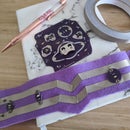Introduction: How to Recycle PLA From 3D Prints Into Bowls, Planters and More
At home and work, we're always adding to the waste PLA bin. Support structures, rafts and failed prints all get added to the pile. Rather than add it to landfill, I've saved it up and worked out how to cast it into new shapes. Here's what you'll need to start:
Supplies
- Old toaster oven (not to be used for food after)
- Silicone moulds; make sure to buy moulds made for baking rather than just casting chocolates, etc.
- Pliers
- Old soldering iron
- Safety glasses
- Oven mitts
Optional:
- Blender
Step 1: Sort Plastics
Make sure to only use one type of plastic, and chop down the plastic into manageable pieces. You can also place any wispy bits into the blender to create chipped plastic. This step isn't necessary unless you're trying to use moulds with small corners to fill, eg. the planter mould.
Step 2: Bake
Fill up the bowl with plastics to the brim, and bake at 200 degrees Celsius for ten minutes. You can add the chunkier prints that are harder to chop down in the bowls and they will melt down fine. Once melted to the point where the surface of the plastic is flat, add another few handfuls of plastic on top and repeat the process.
It's important to make sure you're running a timer during this process. If you let it bake too long it will start to turn brown on the top. It's important to keep adding more at the right steps to avoid browning.
A little bit of smoke may come from the oven while cooking, make sure to do this outside or in a well ventilated area. There will be smells.
Doing a bowl will require 2-3 fill up and melt cycles of 10 minutes.
Doing a planter with a mould requires 4-6 fill up and melt cycles, and it's best to fill up with chipped plastic first.
After you're happy with the melted amount in the bowl, grab the second steel bowl and push down firmly to create the 'mould'. Let this cool for 20-30 minutes. You can run these under cool water to help the bowl pop out. Do not get tempted to add in 'release agents' to help pop the bowl out. These will catch on fire.
Step 3: Trim & Clean
After the plastic bowl comes out of the mould, you'll often find it will have rough edges. Using a pair of pliers, trim this away. Use an old soldering iron to smooth the bowl edges over. Make sure you use an old tip for this as you will have a lot of trouble soldering with this after.
The bowl's edge will have a wavy 'double edge' to it. I use the soldering iron to seal these both together into one chunky looking edge.
After this has cooled, repeat the process of trimming away any curled, melted plastic from the soldering iron. Run the iron over one final time to smooth the trimmed areas.
Your bowl is complete! These are great for putting your keys or loose bits and pieces in. They will not be food safe as small bubbles can often form during melting which can trap bacteria. Make sure to store inside out of the sunlight and heat.
Step 4: Finished!
Enjoy your new bowls and planters.











